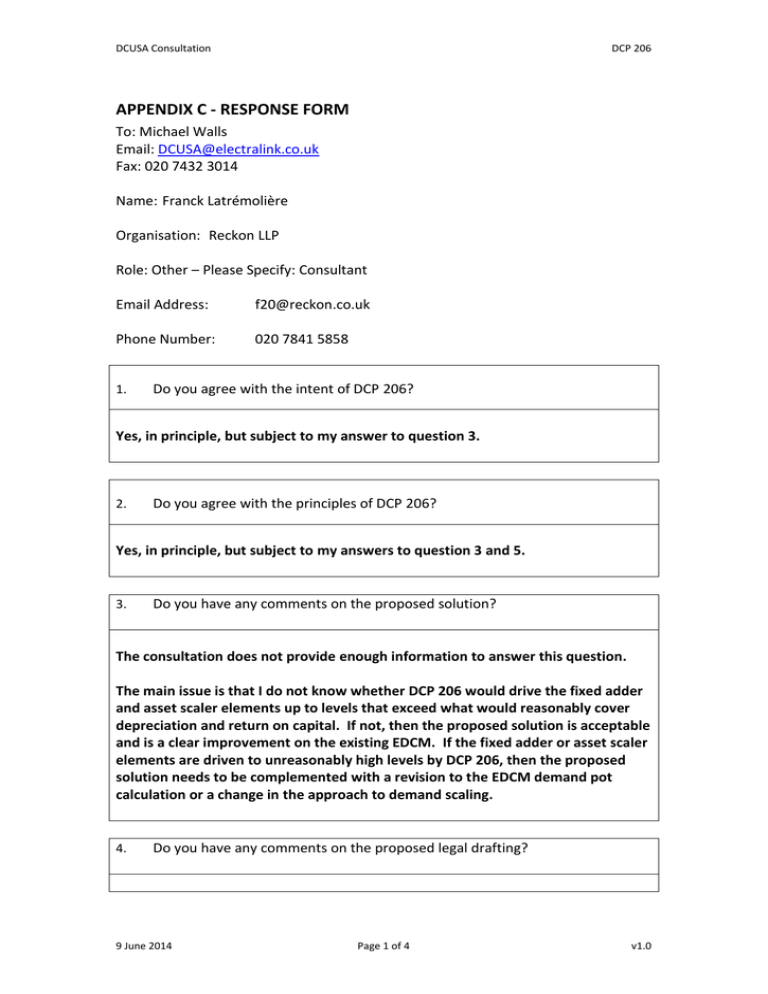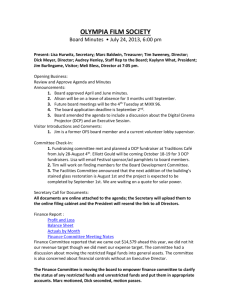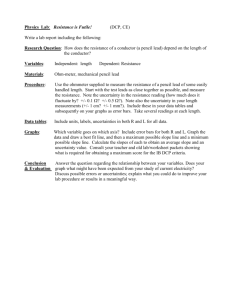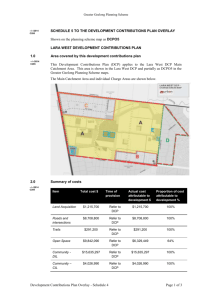DCP 206 response from Reckon LLP (4 pages
advertisement

DCUSA Consultation DCP 206 APPENDIX C - RESPONSE FORM To: Michael Walls Email: DCUSA@electralink.co.uk Fax: 020 7432 3014 Name: Franck Latrémolière Organisation: Reckon LLP Role: Other – Please Specify: Consultant Email Address: f20@reckon.co.uk Phone Number: 020 7841 5858 1. Do you agree with the intent of DCP 206? Yes, in principle, but subject to my answer to question 3. 2. Do you agree with the principles of DCP 206? Yes, in principle, but subject to my answers to question 3 and 5. 3. Do you have any comments on the proposed solution? The consultation does not provide enough information to answer this question. The main issue is that I do not know whether DCP 206 would drive the fixed adder and asset scaler elements up to levels that exceed what would reasonably cover depreciation and return on capital. If not, then the proposed solution is acceptable and is a clear improvement on the existing EDCM. If the fixed adder or asset scaler elements are driven to unreasonably high levels by DCP 206, then the proposed solution needs to be complemented with a revision to the EDCM demand pot calculation or a change in the approach to demand scaling. 4. Do you have any comments on the proposed legal drafting? 9 June 2014 Page 1 of 4 v1.0 DCUSA Consultation DCP 206 No. 5. Would you prefer the implementation date to be 1 April 2015 or 1 April 2016? The consultation does not provide enough information to answer this question. I do not think that there is a need for a long notice period in respect of price reductions. The only issue is about the impact of the increase in the fixed adder and asset scaler elements of the charges. If, after DCP 206 implementation, the fixed adder and asset scaler elements are at or below what would reasonably cover depreciation and return on capital, then the implementation date should be 1 April 2015. In this case, I think that the undue benefit that some customers are currently receiving as a result of the application of charge 1 can be terminated with only a few months notice. If DCP 206 implementation would drive the fixed adder and asset scaler elements up to levels that are above what would reasonably cover depreciation and return on capital, then the implementation date should be 1 April 2016 or preferably 1 April 2017. This would give time to the affected DNOs to develop a revised EDCM demand pot calculation method to eliminate the excessive fixed adder and asset scaler charges ahead of DCP 206 implementation, or to make other changes to the EDCM to address the problem. (This delay would presumably not preclude any customers that are suffering unjustified charge 1 costs from seeking a direct remedy from the DNO.) If the situation is significantly different in different DNO areas, then different approaches to implementation should be adopted. The FCP/LRIC situation is a precedent for using different EDCM methodologies in different DNO areas, and in this case the differences would be merely transitory. 6. Are you aware of any wider industry developments that may impact upon or be impacted by this change proposal? If so, please give details. No. 7. Has the Working Group correctly identified the benefits and drawbacks of DCP 206? If not, please explain how the analysis should be improved. The list of benefits and drawbacks is good in principle. I agree with the benefits identified in the consultation document. 9 June 2014 Page 2 of 4 v1.0 DCUSA Consultation DCP 206 Unfortunately, there is not enough information to form a view on whether the drawbacks are significant. In particular, without knowing the aggregated input data mentioned at paragraph 7.9, I cannot determine how much is being charged through the asset scaler and fixed adder before and after DCP 206, and I cannot do any scenario analysis of how plausible future changes in costs, volumes or price controls might affect these charges. Therefore, I cannot form a view on whether the rates of return implied by the demand scaling charge would be driven to excessive levels by DCP 206. If they would, then that would be a drawback of the DCP 206 solution, which could warrant delaying implementation and/or developing an alternative solution. The reasons for non-disclosure given at paragraphs 7.9 and 8.15 of the consultation document are inoperative given that the data in question relate to each DNO area as a whole rather than any customer. I do not think that removing a charge 1-based unit rate is a drawback of the DCP 206 solution, even if a unit rate was to be reintroduced in the future. 8. Do you feel that DCP 206 will better facilitate any of the DCUSA General or Charging Objectives? Please provide supporting comments or evidence that might help the Working Group improve its assessment. Implementation of DCP 206 would facilitate competition in generation for the reasons given in the change proposal form. Although it is true that this is likely to be significant in only a small minority of cases, it is nevertheless important as any distortion of generation markets by distribution monopolists would be a very serious matter. Implementation of DCP 206 would facilitate competition in supply for the reasons given in the change proposal form. The consultation document notes that other aspects of the EDCM are also opaque and unpredictable. Some of the opacity is caused by DNOs’ refusal to be transparent, as discussed in my answer to question 7; this should be resolved separately and gives no reason to maintain charge 1. Some of the opacity and unpredictability is more fundamentally embedded in the EDCM, in particular the network use factor calculation; whilst these other areas of opacity and unpredictability do reduce the benefits from DCP 206, we need to start somewhere to resolve the opacity and unpredictability, and removing charge 1 is a step in the right direction even if it does not solve all the problems. Implementation of DCP 206 would facilitate competition in distribution for the reasons given in the change proposal form. I think that this effect relates to competition between licensed distribution and private networks; DCP 206 probably does not materially facilitate competition between licensed distributors. Implementation of DCP 206 would facilitate the cost-reflectivity objective for the 9 June 2014 Page 3 of 4 v1.0 DCUSA Consultation DCP 206 reasons given in the change proposal form and illustrated in the case study. However, there might be a detrimental effect if DCP 206 would drive the asset scaler and fixed adder to levels that are too high to be justified as a reasonable charge for depreciation and return on capital. The consultation does not provide enough information to determine whether this last effect is relevant. I agree with the consultation document that the other objectives are not materially affected. 9. Do you have any further comments on DCP 206? No. This form should be submitted to DCUSA@electralink.co.uk no later than 11 July 2014. 9 June 2014 Page 4 of 4 v1.0







